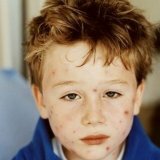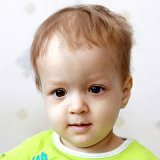Perinatal encephalopathy
 Perinatal encephalopathy - a collective term including various noninflammatory lesion tissue structures of the brain, with the development of a dysfunctional state that is caused by various etiopathogenic factors, hypoxia, exposure to traumatic, infectious agents, toxic-metabolic changes act in utero or during childbirth. The perinatal period covers the period from 28 weeks of intrauterine stay to 8 weeks of extrauterine life. It is during this period that the causal factors listed above can act.
Perinatal encephalopathy - a collective term including various noninflammatory lesion tissue structures of the brain, with the development of a dysfunctional state that is caused by various etiopathogenic factors, hypoxia, exposure to traumatic, infectious agents, toxic-metabolic changes act in utero or during childbirth. The perinatal period covers the period from 28 weeks of intrauterine stay to 8 weeks of extrauterine life. It is during this period that the causal factors listed above can act.
The diagnosis of perinatal encephalopathy does not imply a specific pathology, that is, even isolated in a separate nosological unit can not be. This is more likely the first bell, that the child has syndromic manifestations in the brain and the baby needs to be further examined by narrow specialists, in order to exclude the development of pathological changes in the future. The diagnosis is cunning because its manifestations are very diverse, which complicates early diagnostic measures and differentiation from other organ diseases.
Encephalopathy perinatal genesis refers to the group hypoxic vascular damage, so can often meet term "perinatal hypoxic encephalopathy".
In the structure of general damage to the nervous system, encephalopathy perinatal genesis is more than 62%, and according to the statistics of 3-5% of newborns are born with signs of minimal brain disorders.
Perinatal encephalopathy occurs very often, but is not a sentence, because at this stage of development of medical technologies, responds well to treatment. But, it is worth noting that it is important early timely intervention, the course of therapy itself is very long and requires vigilant attention and control by the parents.
What is perinatal encephalopathy?
diagnosis of perinatal encephalopathy implies melkoochagovogo diffuse brain injury in the context of the research can be considered a disease as a result of oxygen starvation of the brain tissue or any obturativnyh mechanisms arteries with their narrowing that impedes normal blood flow and delivery of oxygen molecules. Also, it is not uncommon for the lesion to occur after a toxic effect, that is, for various diseases with medicamental influence. In any of these cases, the cortex and subcortical white matter are affected, which, if untimely, leads to severe consequences, up to tetraplegia and intellectual insufficiency.
Perinatal hypoxic encephalopathy in the prevailing majority declares itself syndromally: with oppression or vice versa, an increase in CNS excitability, motor disorders, hydrocephalic complications, convulsive status, VSD, motor and speech development delay.
Perinatal encephalopathy is subdivided into the following types:
• Hypoxic - activated by shortage of oxygen supply channel of the peripheral blood or birth asphyxia. Its subtype is hypoxic-ischemic, when serious destructive processes that occur in the foci of tissues join. Etiologically provoked by smoking, stress and alcohol abuse.
• Post-traumatic, or residual form - occurs when the birth injury: presentation by the buttocks or transversely, provokes its obstetric error, unfavorable conditions of labor, anomalies of labor. Can be formed as soon as, and after months and years. Is manifested by migraines, mental problems, intellectual insufficiency, learning difficulties.
• Toxic - develops under the influence of toxic substances in infections, alcohol, drugs, poisoning with chemicals( lead, carbon monoxide).
• Toxic-metabolic - in the case of organ defects in the development of the fetus, the inflammatory processes of the mother during gestation. With intragroup metabolic intoxication and the body's inability to self-eradicate poisons( eg, bilirubin encephalopathy in hemolytic disease).
• Diabetic perinatal encephalopathy - brain damage, against diabetes mellitus with disorders of the metabolic process.
• Radiation - when irradiated with ionizing waves.
• Dyscirculatory, or vascular perinatal encephalopathy - is inherent in senile age. The cause of this form in the defeat of the vessels, with already existing diseases such as osteochondrosis, dystonia, increased intracranial pressure. This form is inherent in the old.
• Infectious - under the influence of persistent infections in the body.
• Transient perinatal encephalopathy - transient disorders, manifested in a brief loss of consciousness, alternating vision impairment.
There is a classification of the periodicals of perinatal encephalopathy:
• Acute period - lasts up to 1 month of life.
• Restorative - early to six months and late up to a maximum of 2 years.
• Initial or period of residual manifestations.
diagnosis of perinatal encephalopathy is based on the life history, and the results of extensive simptomokomlekse following instrumental studies of the brain:
• ultrasound( neurosonography) - safe method of examination of tissue, cerebrospinal fluid spaces, anatomical structures through nezarosshy anterior fontanelle. You can determine the intracranial lesions and their nature.
• Electroencephalography - allows identifying leading syndromes, is 100% informative for predicting the consequences( deafness, vision loss, cerebral palsy).
• Doppler ultrasound is useful for evaluating the pathology of cerebral blood flow.
• Conduction of CT and MRI of age is difficult because children need to be injected into anesthesia.
• Obligatory approach to the ophthalmologist is required, as changes on the fundus verify the level of intracranial hypertension.
• Neurologist examination, with an advisory opinion and recommendations for further action.
Causes of perinatal encephalopathy
Risk factors for the occurrence of the disease, perinatal encephalopathy include:
- Infectious acute illness arising from the carrying of a pregnancy woman child, especially dangerous in terms of mortality, measles and developed pneumonia.
- Chronic diseases( heart defects, hypertension, anemic manifestations, diabetes, disorders in the renal system, surgical operations), hereditary and genetic abnormalities of the metabolism, pathology of the endocrine system, fluctuations of the hormonal background.
- Tobacco smoking, alcoholism, drug addiction.
- Young age of parturient woman is 17 or older than 31 years.
- Unfavorable influence of ecology( ionizing radiation, toxic damage by medicinal substances, salts of heavy metals, gas contamination of air from machines).
- Poor conditions of rest and work associated with interaction with chemicals, under the influence of radiation, vibration, physically heavy with lifting weights.
- Disturbances in nutrition, which entails the development of such a phenomenon as gestosis - internal swelling dangerous for children's life.
- In the history of repeated medical abortions, true repeated miscarriages and prolonged female infertility.
- Pathology of the gestation period itself: toxicosis, threat of interruption and presence of placental chronic insufficiency.
- Anomaly generic process: rapid delivery or prolonged, early discharge of water and as a result, anhydrous period is prolonged, cord entanglement, premature placental abruption, cesarean section, incompatibility of the fetal head when pathologically narrow pelvis, presentation buttocks or multiple births, obstetric traumaWhen assisting the parturient woman.
- After birth, the incompatibility of the mother and the baby by blood, their rhesus-conflict, is much less negative because of group incompatibility.
Symptoms of perinatal encephalopathy
clinical picture of the disease, perinatal encephalopathy is very diverse and has many faces, depends mainly on the area and depth of the lesion lethal force in the brain, the child's age, the causal agent and the duration of its effect. For differentiation, a syndrome system was created. All syndromes can not be present simultaneously, more often it is a combination of several, with one prevailing.
There are a number of inherent signs of perinatal encephalopathy that help in time to suspect the wrong:
- a weak late cry;
- heart problems at birth;
- weakness or increased muscle tone;
- inadequate responses to external stimuli;
- spontaneous flinch;
- absence of physiologically induced reflexes - sucking, swallowing, search;
- excessive nervous overexcitation;
- hysterical, hysterical, with a breakdown in voice and heavily weakened crying;
- oculomotor nerve damage;
- tilting the head;
- frequent regurgitation, vomiting, gastrointestinal disorders, which may or may not be related to food intake;
is a dissomnia.
At an older age it is important to notice such symptoms: disturbances in the sphere of mental processes( memory, attention, perception of information);Passivity to everything that is happening, speech disturbance, apathy;Oppressed state, lack of initiative, unwillingness to participate in the game, not contact, narrowed circle of interests, absent-mindedness, irritability, bad sleep, dizziness, migraine pain, hypotension.
The following signs of perinatal encephalopathy are asymetrically marked:
- Increase of neural-reflex excitability. It appears in the tremor of the chin, hands and feet, anxiety with bad surface sleep and flinches, excessive lethargy, stiffness, increased reactions to sound and light, uncontrollable loud crying, thermoregulation failure. In premature babies - cramps.
- General CNS depression. All the indices are lowered: muscle tone, reflexes, depressed consciousness, cry quiet and weak, babies quickly get tired during feeding or they completely disappear the sucking reflex, different tonus of the musculature of the body and distortion of facial features, anisocoria, ptosis, nystagmus.
- Comatose syndrome. Feel deep defeats, depressing vital functions, with the transition to coma, convulsive seizures. More often this condition is observed with massive hemorrhages and brain edema, characteristic of birth trauma and asphyxia. They are treated only under conditions of constant supervision in the intensive care unit on the ventilator.
- Motor disorders are the most common. They manifest themselves in violation of the normal formation of muscle tone, with muscular hypo-, hypertonus or dystonia, hyperkinesis( non-purposeful, chaotic movements), impaired coordination, paresis and paralysis, psychomotor and speech retardation of development.
- Hypertensive hydrocephalus is one of the most serious and common, as it can go into hydrocephalus requiring surgical intervention. Anatomically, there is excessive production of intracranial fluid with an increase in intracranial pressure. Appears tension and bulging of the fontanel, divergent seams of the skull, an increase in the circumference of the head by 1-2 cm, a violation of sleep, there are piercing screams against the background of monotonous crying, tilting the head. Among the local symptoms it is important to note: strabismus and nystagmus, asymmetry with mandibular sagging, uneven mimic muscles. A characteristic "Gref" symptom - when you turn your eyes down and up, a white strip of cornea appears.
- Convulsive syndrome, or epileptic. The difference is short, a sudden sudden onset, a chaotic principle of repetition and is independent of the sleep or feeding regimen. The convulsions themselves are observed in the form of small-amplitude trembling, automatic chewing movements, short-term apnea, trembling of feet, hiccups, regurgitation, excessive salivation. These cramps are similar to normal movements, which makes diagnosis difficult.
- Cerebranic Syndrome. Mark motor disorders by the type of shudders, with absolutely normal mental and physical development of the baby.
- Vegeto-visceral. Disturbances of microcirculation: marbling of the skin, acrocyanosis, cold hands and feet;dyspepsia with intestinal colic;lability of the cardiovascular system( tachy- and bradycardia, arrhythmias).Often enteritis and enterocolitis( inflammation of the intestine with diarrhea and violation of weight gain), rickets of different degrees of severity.
- Hyperactivity. It is expressed in the inability to concentrate and concentrate attention.
The problem of perinatal encephalopathy is that the disease is similar to other CNS diseases too much. Therefore, the first signs can be misinterpreted, which leads to a transition to more difficult stages, which are difficult to correct and treat. Parents should be alarmed by constant unreasonable anxiety, poor sleep, lethargy, twitching, sluggish sucking, regurgitation.
Treatment of perinatal encephalopathy
Children already starting with moderate stages and further, in need of inpatient treatment. With mild forms, you can confine yourself to outpatient supervision in specialists, with the selection of adequate treatment regimens.
Treatment of perinatal encephalopathy takes a long period of time. Usually 2-3 courses of therapy are needed per year.
Among the treatment methods are the following:
- Injection blockade;
- Metabolite and antioxidant therapy, vascular and reflexotherapy;
- Physiotherapy methods: CMT, UHF;
- Osteopathic treatment or orthopedic correction. After traumatic impact during labor, it is recommended to weaken the consequences of the birth stress and correct the tension of the bones of the skull, restore their proper location and fusion in the future.
- Therapeutic massage. For correction of muscle tone, development of motor functions. Applicable techniques: articular, radicular, muscular;
- Gymnastics, or exercise therapy, and swimming. For the development of muscles and mobility, relieving stress in the body of the baby.
- Phytotherapy. It is very often used in perinatal encephalopathy, because the use of herbs minimizes the consequences. These are phyto-tea from dandelion, plantain, mint, sporis, sweet clover, cowberry, St. John's wort, melissa, ayr, oregano. But strictly after consultation with the attending physician;
- Aromatherapy. Improve the general condition of essential oils of chamomile, ginger, lavender, rosemary;
- Rational feeding. Breastfeeding is vitally important for a baby, because despite the variety of the pharmaceutical line of milk formulas, even the best quality, expensive and adapted mixtures are the metabolic load on the baby's body. It is proved that natural cure is faster cure, such children have higher rates of emotional and physical development;
- Baths. Their action is similar to the use of sedatives.
Medication postindromal therapy of perinatal encephalopathy:
- In muscular pathology and paresis, drugs that improve neuromuscular transmission are introduced - Dibazol, Galantamine. With hypertension - Midokalm, Baclofen. The administration of these drugs is applicable orally or by electrophoresis.
- In hypertensive hydrocephalus: lying in bed with an elevated head end up to 30 °.Among the phytopreparations prefer - horsetail field, bearberry leaf. In more severe cases - Diacarb( reduces the production of cerebrospinal fluid and facilitates outflow).In critical situations, surgery of the neurosurgical profile is indicated. In addition, hemodialysis, mechanical ventilation, and parenteral nutrition are applicable.
- With epileptic syndrome - taking anticonvulsant anticonvulsants, under the control of laboratory tests and EEG.
- Psychomotor lag of development uses drugs that activate mental activity, normalize the cerebral blood flow, have the ability to form new intercellular connections - Nootropilum, Pantogam, Actovegin, Cortexin.
- Groups of vitamin complexes, especially the B group, are required.
Consequences of perinatal encephalopathy
Consequences of perinatal encephalopathy are usually eliminated by the first year of life, but other mechanisms of the course of the disease are likely. Signs disappear or show little with adequate timely treatment and then the perinatal encephalopathy disease does not have a significant impact on the future development of the child's CNS system.
But cases of development burdening the life of a baby are not uncommon; they are referred to as:
- cerebral dysfunction( moderate manifestations of hydrocephalus, asthenia, nervous states, behavioral deviation and learning process difficulties);
- the most serious - is cerebral palsy of children and oligophrenia;
- epileptic disorders;
- osteochondrosis of childhood;
- severe migraine headaches;
- neurocirculatory dystonia;
- hypertension;
- scoliosis;
- vision impairment,
- motor development underdevelopment;
- tempo delay in the development of the physical, mental, motor and speech systems.



